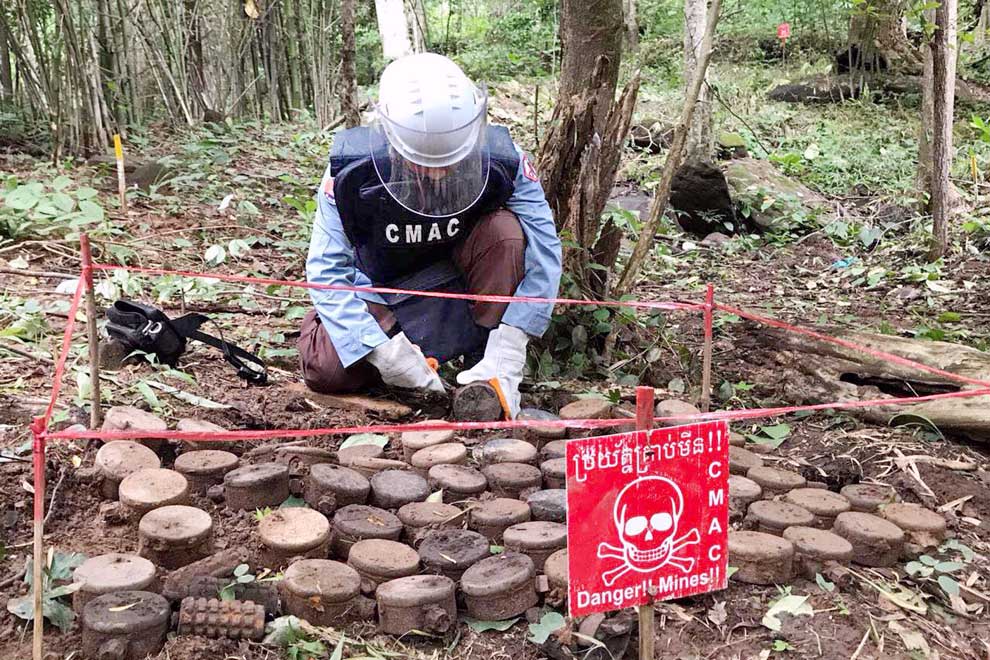
The Cambodian Mine Action Centre removed some 36,000 landmines from 67 sq km of land this year. Cmac’s facebook page
Throughout this year, the Cambodian Mine Action Centre (CMAC) had detected and destroyed more than 36,000 mines and unexploded ordnance (UXOs) on nearly 6,700ha of mine-contaminated land across 487 locations in the Kingdom.
The government also vowed to clear mines completely by 2025, said a CMAC report released on Wednesday.
CMAC director-general Heng Ratana said the organisation managed to detect and destroy a total of 36,515 mines and UXOs on 66.967sq km (nearly 6,700ha) of land. Of these, 5,415 were anti-personnel mines, 75 anti-tank mines, 15 improvised mines and 30,660 UXOs.
Around 371,200 signs were installed to demarcate mine-contaminated lands in response to 3,144 Explosive Ordnance Disposal (EOD) calls.
“The results of mine clearance activities this year have benefited 40,850 families directly and more than 50,000 indirectly, accounting to nearly one million people,” he said.
However, Ratana noted that the number of implemented mine action plans this year had decreased by eight per cent compared to last year, which saw up to 82 per cent of plans on 110sq km of land fulfilled.
More than 75sq km was also cleared last year, which is greater than this year’s 67sq km.
The decline was said to have been caused by a change in mine-clearance plans and forces to make way for research in mine-hazard areas.
“We increased research and installed signs to mark mine-contaminated areas on nearly 900ha. Through the UN Development Programme’s (UNDP) Clearing for Results project, we have launched research studies in 386 villages in Pailin, Battambang and Banteay Meanchey provinces.
“We have also detected mine-contaminated areas in 622 locations, covering 96.287sq km,” he said.
Besides clearing mines and UXOs, CMAC had conducted a total of 11,230 visits to various areas in the Kingdom to spread awareness on the dangers of mines and remnants of war and to seek aid to support mine victims.
Ratana said CMAC had also contributed to the development of physical infrastructures in mine-threatened areas and the enhancement of skills and capacities of the authorities, especially the Infantry command, in mine action response.
“This year, we trained more than 300 volunteer officials from the National Police and more than 300 from the Royal Cambodian Armed Forces in mine clearance procedures.
“Our unit, with the support of the Japan International Cooperation Agency (Jica) and Japan International Cooperation System (Jics), also trained specialists from Iraq, Iran, Colombia and Laos. A total of 115 participants attended the training,” he said.
Last month, the government in accordance with the Mine Ban Treaty, recommitted to clearing mine-contaminated lands across the Kingdom by 2025. To achieve this goal, CMAC called for support from international communities and the government itself.
At present, some 2,100sq km remained threatened by mines and UXOs.
Since 1992, Japan has been at the forefront of countries that consistently provided aid for mine clearance work in Cambodia. Others are the US, South Korea and China.
China had recently provided CMAC with $2.5 million to support mine clearance activities from 2020-2023 in Preah Vihear, Oddar Meanchey and Stung Teng provinces.
This aid will also be used to support mine-intervention forces in Siem Reap, Kampong Chhnang and Kampong Thom provinces, in line with plans to clear mines on more than 17sq km.











